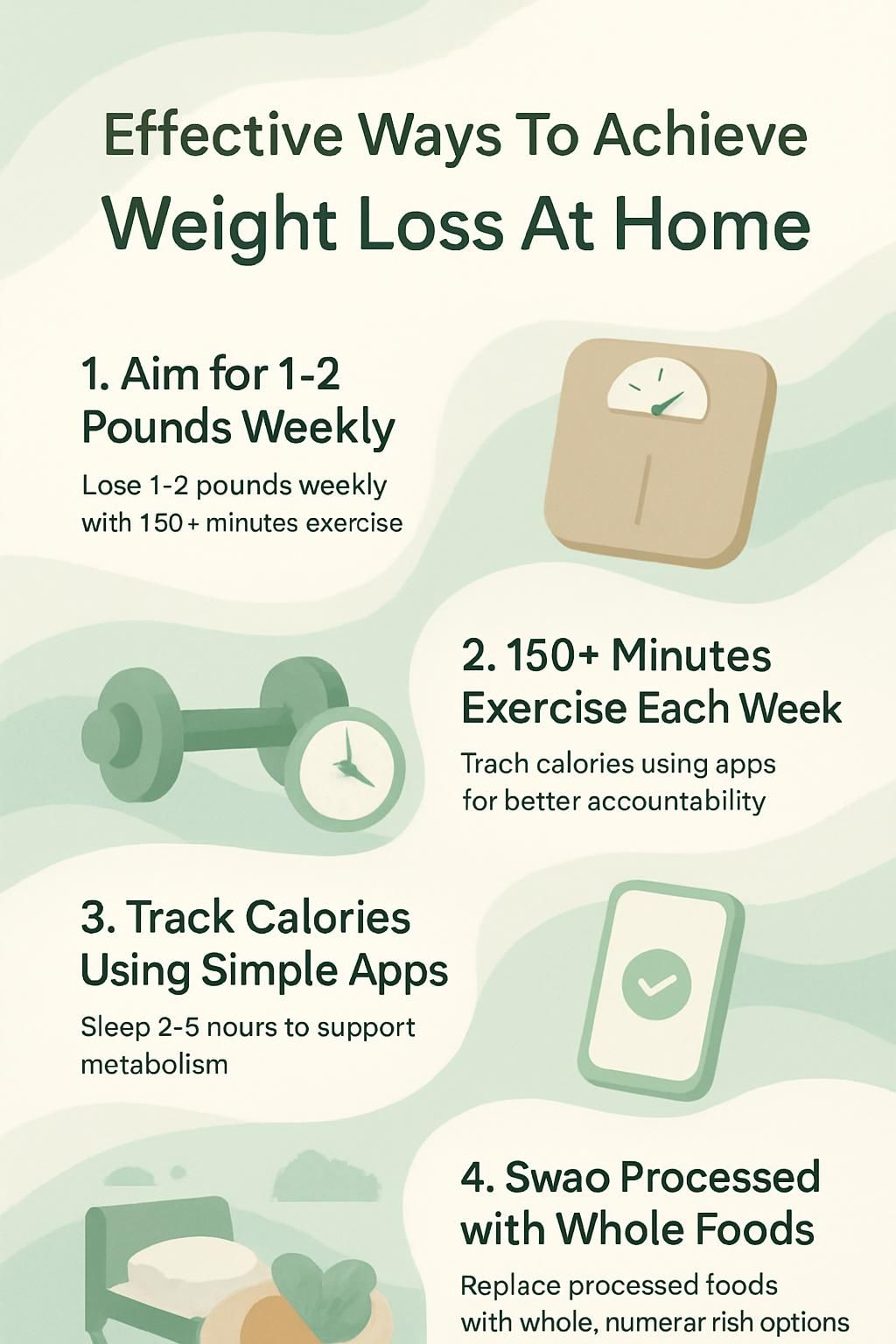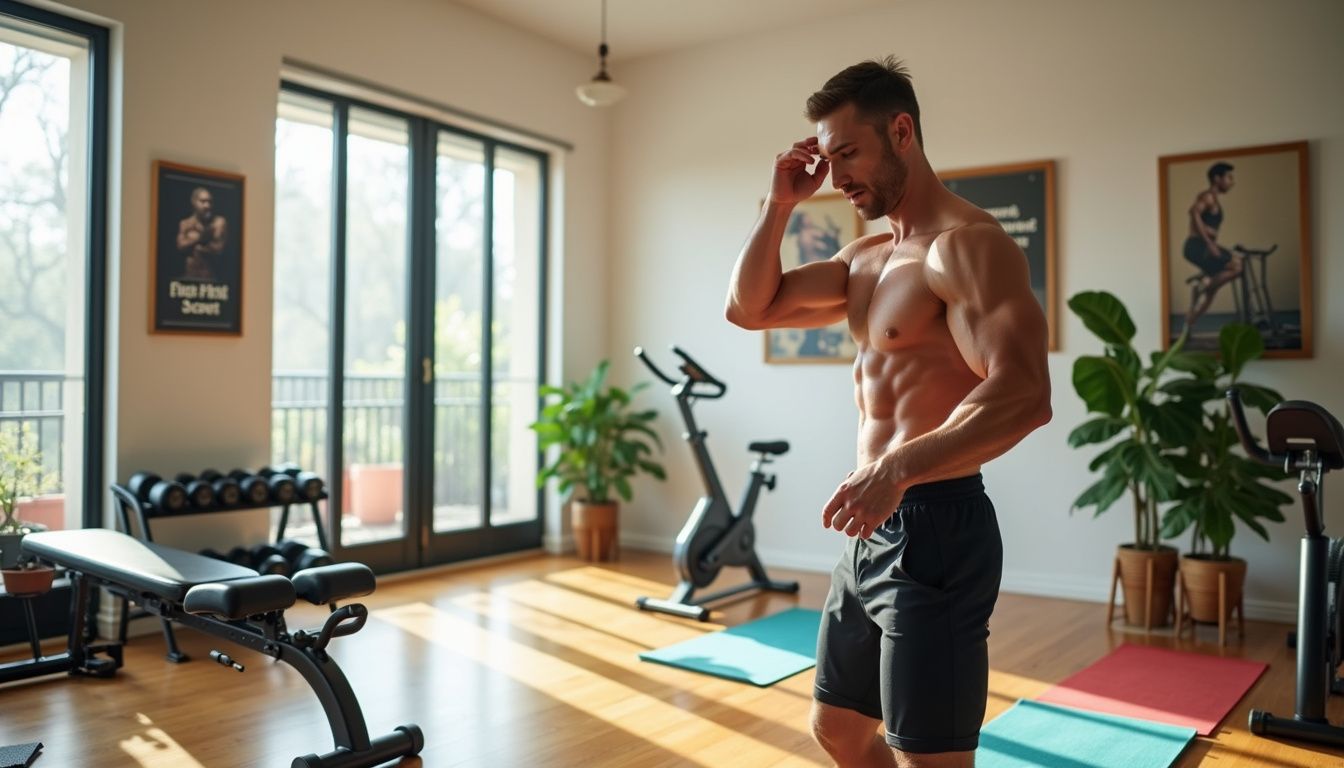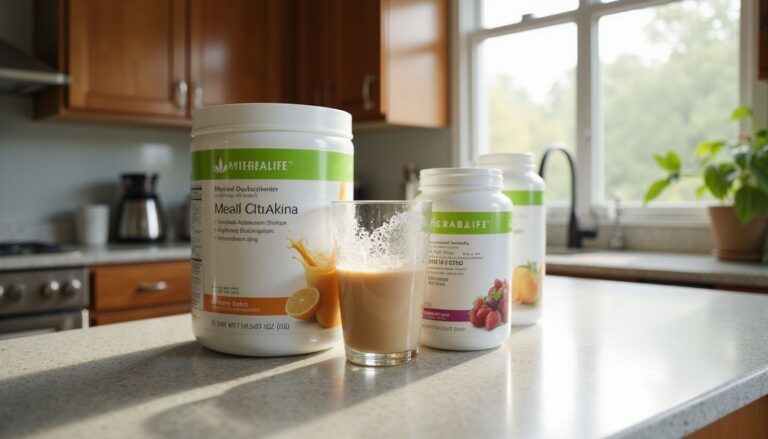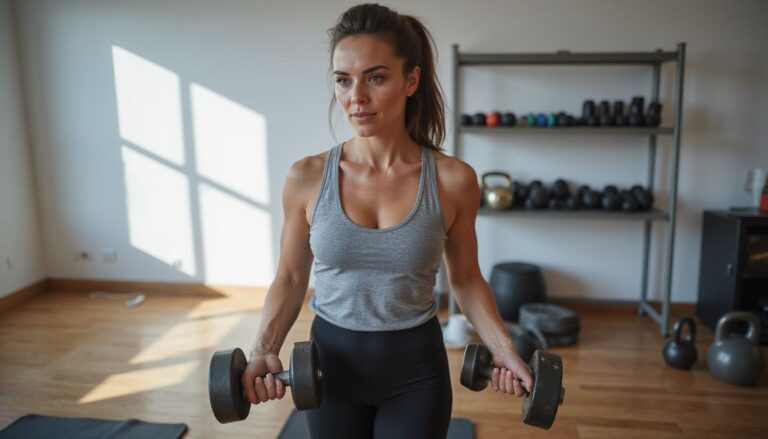Effective Ways To Achieve Weight Loss At Home
Our Nutrition Assistant AI Suite will transform your body. You will lose fat, get toned, and build muscle. Gain confidence and optimal health.
Want to lose weight but dread crowded gyms or strict diet rules? More than 70 percent of American adults live with overweight or obesity, which raises the risk of heart disease and type 2 diabetes, according to the CDC.
This guide on weight loss at home gives you clear, science-backed steps. You will learn how to improve meals, move more, and build routines that fit real life. Start with one change today and stack wins over time.
Key Takeaways
- Over 70 percent of U.S. adults have overweight or obesity, which raises risks for heart disease and type 2 diabetes.
- Combine a calorie deficit, 150 minutes of weekly aerobic exercise, and two strength sessions. This plan supports losing 1–2 pounds per week safely.
- Swap processed foods and added sugar for whole grains, lean protein, fruits, and vegetables to feel full and support long-term loss.
- Use apps like MyFitnessPal or Lose It! and wearables to track calories, activity, and habits that affect your weight.
- Consistent sleep, mindful eating, meal prep, and stress control help your metabolism and support steady progress at home.

Key Strategies for Weight Loss at Home

Small, steady changes add up. A few daily habits can help you manage weight and live a healthier life at home.
What is a balanced approach to weight loss?
A balanced approach blends healthy eating, regular exercise, and simple lifestyle shifts. Create a calorie deficit, which means eating fewer calories than you burn.
Build meals around nutrient-dense foods. Choose lean protein, whole grains, fruits, and vegetables. Limit added sugar, refined grains like white bread and white rice, and highly processed snacks that are high in salt or fat.
The CDC suggests at least 150 minutes of moderate aerobic activity each week. Add strength training on two or more days to maintain muscle and support fat burning.
People who combine healthy eating and regular exercise lose more weight and keep it off longer than those who use only diet or only exercise. I tracked portions and added vegetables to each meal, and I lost 10 pounds without feeling deprived.
Experts encourage a safe pace of 1 to 2 pounds per week.
Effective weight management involves healthy food choices, increased physical activity, and realistic goal setting.
What are the benefits of losing weight at home?
Home is a powerful place for change. You control your food, schedule, and environment.
Cooking at home helps you choose whole ingredients and skip vending snacks and sugary drinks. Home workouts remove cost, weather, and commute barriers. Even ten-minute bodyweight sessions help burn calories.
Many people also save money by cooking more. Smart scales and trackers make progress easy to see. A simple trick like using smaller plates helped me eat less and reduce stress around food.
How Can Nutrition Help You Lose Weight?
Nutrition drives progress. Better food choices help you lose weight safely and may lower the risk of chronic diseases.
How can I add protein to my meals for weight loss?
Protein helps you feel full, maintain muscle, and may raise your daily calorie burn. Try these easy ideas:
- Add eggs at breakfast for a filling, high-quality protein source.
- Choose Greek yogurt or cottage cheese instead of sugary snacks to boost protein and support digestion.
- Mix nuts or seeds into salads, cereal, or oatmeal for protein and fiber.
- Use lean meats like chicken breast, turkey, or fish at lunch and dinner to aid fat loss.
- Add beans or lentils to soups, stews, and salads for a budget-friendly protein boost.
- Consider whey protein in a smoothie if meals fall short on protein, especially after training.
- Cook tofu or tempeh in stir-fries for plant-based protein with little saturated fat.
- Snack on hard-boiled eggs instead of chips to curb cravings.
- Use a sprinkle of low-fat cheese on whole grain pasta for taste and protein.
- Pair protein with fruits or vegetables to increase fullness while managing calories.
I often add shredded chicken to vegetable soup. It keeps me full through busy afternoons.
Which whole, natural foods should I choose?
Whole foods support weight control and overall health. They offer fiber, vitamins, and minerals that help your body work well.
- Fruits like berries, apples, and oranges provide vitamins, fiber, and helpful plant compounds without excess sugar.
- Leafy greens such as spinach, kale, and romaine are low in calories and rich in nutrients.
- Whole grains like brown rice, quinoa, and oats deliver steady energy and support blood sugar control.
- Nuts and seeds, including almonds and chia, add protein and healthy fats. Keep portions small.
- Lean proteins such as eggs, chicken, tofu, and salmon support heart health and muscle.
- Beans and lentils feed gut bacteria and promote fullness due to their fiber.
- Colorful vegetables at every meal supply a wide range of vitamins.
- Starchy vegetables like sweet potatoes provide balanced carbs that support steady energy.
- Plain Greek yogurt or cottage cheese offers calcium without added sugar.
- Olive oil and avocado supply healthy fats that fit well in a balanced diet.
Adding more colorful vegetables made my meals taste better and reduced cravings for sweets. Variety also kept me on track after a stressful year of weight gain.
Why should I limit processed foods and sugary items?
Highly processed foods and sugary items often pack extra calories, salt, and additives. They can spike blood sugar, which leads to a crash and more hunger.
Over time, frequent spikes may promote fat storage around the belly. This pattern raises heart disease risk, as noted by the American Heart Association.
Sugary snacks and drinks make it easier to overeat. During a period of keeping a food diary, I noticed I grabbed sweets without thinking, which slowed my goal of losing 20 pounds. Swapping in nuts or fruit cut bloating and kept my energy steady.
Choose foods with short ingredient lists, less sugar, and minimal processing.
How can I eat more fruits and vegetables?
Small shifts make produce a daily habit. Try these steps:
- Stir chopped spinach or tomatoes into eggs for breakfast.
- Prep snacks like carrot sticks, apple slices, or celery with nut butter.
- Add produce to every meal, such as berries in oatmeal or greens in sandwiches.
- Keep washed produce at eye level in the fridge to nudge better choices.
- Stock frozen options. They are often as nutritious as fresh and last longer.
- Replace half of white rice or pasta with cauliflower rice or zucchini noodles.
- Cook a new seasonal veggie each week to keep meals interesting.
- Fill smaller plates with fruits and vegetables first to guide portions.
- Choose water with lemon or cucumber instead of sugary drinks.
Planning meals on Sundays helped me hit my daily produce goal. Keeping fruit visible on the counter also worked.
How much water should I drink to support weight loss?
Aim for at least 8 to 10 cups of water per day. Drinking a glass before meals can help reduce calories. The National Academies suggests a total fluid goal near 91 ounces for women and 125 ounces for men from drinks and water-rich foods.
I tried a glass of water before each meal and felt satisfied with smaller portions. Good hydration supports your metabolism and helps exercise feel easier.
Physical activity works better when you are hydrated. Next, build a simple home workout plan to increase calorie burn.
Effective Home Workout Routines for Weight Loss
Home workouts can torch calories and protect muscle. They also support heart health and reduce belly fat.
What are the best cardio exercises to do at home?
Cardio raises your heart rate and burns energy fast. You need little space and no special gear to start.
- Jumping jacks quickly elevate heart rate and use many muscles. Ten minutes can burn roughly 100 calories.
- High knees, running in place with knees lifted, builds leg strength and improves circulation.
- Burpees target the whole body and are a proven calorie burner.
- Mountain climbers mimic running in a plank. They boost breathing and work your core.
- Dancing for twenty minutes is fun and effective. Upbeat music helps you move longer.
- Shadow boxing raises your heart rate, works your arms, and can ease stress.
- Step-ups on stairs build leg strength while delivering solid cardio in a short time.
Mixing these moves four days per week jumpstarted my progress after months at home. Pair cardio with smart nutrition for best results.
How do strength training and resistance exercises aid weight loss?
Strength work builds muscle, which burns more calories at rest. It also protects bones and reduces injury risk.
- Use dumbbells, bands, or bodyweight to add resistance and build lean muscle.
- Plan two to three strength sessions per week for steady progress.
- More muscle means a higher daily calorie burn over time.
- Resistance training supports joint and bone health.
- Combining strength work with a balanced eating plan helps preserve muscle during fat loss.
- Squats, lunges, and push-ups require no equipment and work well at home.
- Research shows pairing strength and cardio reduces more fat than cardio alone.
- A protein-rich snack after training may support muscle repair. Ask a dietitian if you are unsure.
- Reducing deep belly fat improves metabolic health and supports long-term weight control.
Choose a few movements you can repeat each week. Consistency beats intensity that you cannot maintain.
What bodyweight movements can I perform for fat loss?
Bodyweight moves train several muscles at once, raise heart rate, and require no gear. Start with form, then add reps or time.
- Squats: Do 15 to 20 reps to work legs and glutes and boost calorie burn.
- Push-ups: Aim for 10 to 20 reps for chest, shoulders, arms, and core. Do not rush.
- Mountain climbers: Work for 30 seconds to spike heart rate and activate the core.
- Planks: Hold 20 to 40 seconds to build core strength and stability.
- Lunges: Complete 10 to 15 reps per leg to train glutes and legs.
- Burpees: Perform 8 to 12 reps for a full-body calorie burn.
- High knees: Go for 30 seconds to raise heart rate and warm up.
- Glute bridges: Do 12 to 15 reps to target glutes and support the lower back.
- Jumping jacks: Start with 30 seconds and add time as fitness improves.
- Triceps dips: Try 10 to 15 reps using a sturdy chair for arm strength.
Build a short circuit. Repeat it two or three rounds, resting as needed. Progress by adding sets or time.
How can yoga or Pilates help with weight loss?
Yoga and Pilates build strength, balance, and flexibility. Both also teach mindful breathing, which can lower stress and improve focus.
Less stress often means fewer cravings for sugary foods. Studies link regular yoga with lower BMI and less weight gain over time. Pilates targets the core with controlled moves, which improves posture and muscular endurance.
Many people sleep better after steady practice. Better sleep supports appetite control and weight management. Try beginner videos at home and aim for short sessions several times a week.
Which Lifestyle Changes Support Weight Reduction?
Daily habits make your plan stick. Simple routines help you get enough sleep, manage stress, and control portions.
How do I practice mindful eating?
Mindful eating helps you notice hunger, fullness, and emotions around food. It makes it easier to stop when satisfied.
- Sit at a table, away from TV and phones.
- Pay attention to textures, flavors, and smells.
- Eat slowly and set your fork down between bites.
- Listen to your body’s hunger and fullness cues.
- Use smaller plates to guide portions.
- Keep a simple food journal or use a nutrition app.
- Pause with gratitude before eating to boost awareness.
- Talk with your doctor or a health professional if eating feels stressful.
- Choose whole foods that digest well and keep you satisfied.
- Consider intermittent fasting only with medical guidance if you have health conditions.
Why use smaller plates to control portions?
Smaller plates make servings look bigger, which helps you feel content with less food. Research suggests people may eat up to 30 percent less with smaller dishes.
This tip works well with whole grains, lean protein, and vegetables. Combine it with mindful eating to keep calories in check at home.
Next, learn how sleep affects hunger and energy.
How much sleep is needed for weight loss?
Most adults need 7 to 9 hours of sleep per night. People who sleep less than 6 hours often have higher body fat and struggle more with weight loss, according to the National Sleep Foundation.
Rest helps regulate leptin and ghrelin, two hormones that influence hunger. During a busy season, I slept only five hours while training at home. Cravings rose and energy fell until I fixed my sleep routine.
Protecting your sleep makes nutrition and exercise easier to sustain.
What are effective ways to manage stress?
Stress can trigger overeating and stall progress. Use simple tools you can repeat daily.
- Practice deep breathing for five minutes to calm your mind.
- Move your body most days. Walking and cycling boost mood chemicals.
- Get at least seven hours of sleep to help control cortisol.
- Limit caffeine and highly processed snacks to avoid energy swings.
- Drink enough water, since dehydration can raise tension.
- Try yoga or gentle stretching to reduce perceived stress.
- Connect with friends or a support group instead of turning to food for comfort.
- Use meditation or mindfulness apps for quick, guided sessions.
- Enjoy herbal tea, such as chamomile or peppermint, to promote relaxation.
- Set small, realistic daily goals to prevent overwhelm.
- If stress lasts for weeks, contact a healthcare provider for counseling or other care.
Technology Tools to Boost Weight Loss Efforts
Digital tools make tracking easier. They also keep you accountable when motivation dips.
What fitness and nutrition apps can I use?
These apps can help you log food, plan workouts, and monitor progress:
- MyFitnessPal counts calories and tracks nutrients with a large food database.
- Fitbit syncs steps and heart rate from wearables and offers fun challenges.
- Lose It! simplifies meal logging and barcode scanning for packaged foods.
- Cronometer reports detailed vitamins, minerals, and macros for fine-tuning.
- Fooducate grades foods and suggests higher quality options based on labels.
- Noom uses behavior coaching with short daily lessons to change habits.
- Nike Training Club delivers free home workouts for all fitness levels.
I used MyFitnessPal for months and saw clear patterns. Adding a Fitbit raised my daily steps and kept me honest.
How do I track calories and physical activity effectively?
Consistency is key. Log every meal and drink soon after you eat to avoid missing details.
Use trusted databases in MyFitnessPal or Lose It! Scan barcodes for packaged items or enter recipes when you cook. Track steps and workouts with a wearable like a Fitbit or Apple Watch.
Compare calories in with calories out to spot trends. Weekly app reports help you adjust meals, portions, or training when needed.
What are the benefits of smart scales and fitness trackers?
Smart scales and trackers provide real numbers for weight, body fat estimates, steps, and sleep. Seeing progress in charts boosts motivation.
My daily step count rose by 2,000 within a month of using a tracker. You can set reminders to move and drink water. Many devices sync with apps to keep all your data in one place. Some smart scales track multiple users, which helps families.
Use these tools to measure what matters and stay engaged.
How to Build a Sustainable Weight Loss Plan
Lasting change comes from clear goals and repeatable habits. Think progress, not perfection.
How do I set achievable weight loss goals?
Set specific goals that fit your life and health. Aim to lose 1 to 2 pounds per week, a safe rate supported by the CDC.
Record your starting weight, waist size, and daily habits in a journal or app. Break big goals into smaller targets, like the first 5 or 10 pounds. Start with simple steps, such as cutting sugary drinks or walking 30 minutes daily.
Adjust based on results and how you feel.
Why is a consistent daily routine important?
Routines reduce decision fatigue. A set schedule for meals, workouts, and sleep makes healthy choices automatic.
Regular patterns help control hunger and energy. Knowing what comes next lowers stress and helps you stick with exercise and nutritious meals. Over time, consistent actions produce reliable results.
How can I plan and prepare meals ahead of time?
Meal prep saves time and supports better choices during busy weeks. Use this checklist:
- Pick one or two planning days. Write a grocery list focused on whole foods.
- Cook big batches of protein, like chicken or beans, for several meals.
- Wash and chop produce after shopping. Store in clear containers.
- Cook whole grains, such as brown rice or quinoa, and portion them.
- Pack balanced lunches with protein, complex carbs, and produce.
- Track planned meals in an app. Study findings link tracking to better results.
- Make your own sauces and dressings to cut added sugar and sodium.
- Freeze extra soup or stew in single servings for quick dinners.
- Prepare grab-and-go snacks like nuts, yogurt, or cut veggies.
- Review your plan weekly and adjust based on what worked.
Planning removes guesswork. It keeps your calorie intake aligned with your goals.
Which Natural Remedies Can Support Weight Loss?
Some natural options may offer small boosts. They work best alongside diet and exercise.
How does green tea and other herbal teas help weight loss?
Teas can support your plan in simple ways. Many are calorie-free and hydrating.
- Green tea provides catechins, like EGCG, that may raise calorie burn.
- Drinking green tea before exercise can increase fat use during activity.
- Oolong and white tea supply antioxidants that may aid fat loss.
- Unsweetened tea helps you cut calories without feeling deprived.
- Warm tea before meals may reduce appetite and improve portion control.
- Peppermint and ginger tea can soothe digestion and reduce bloating.
- Regular green tea intake has been linked with smaller waist size in some studies.
- Tea helps you meet daily fluid needs for energy and metabolism.
- Replacing sugary drinks with tea reduces added sugar intake.
What probiotic foods improve digestive health for weight loss?
Probiotics are beneficial bacteria that support gut balance. A healthy gut may help control appetite and cravings.
- Greek yogurt with live cultures supports gut health. Choose plain, unsweetened types.
- Kefir is a fermented milk drink rich in probiotics and easy to sip daily.
- Sauerkraut offers probiotics and fiber. Add a few spoonfuls to meals.
- Kimchi combines fermented cabbage with spices for a flavorful boost.
- Miso, a fermented soybean paste, works well in soups and sauces.
- Tempeh is a fermented soy product that provides both probiotics and protein.
- Pickles fermented in brine supply lactic acid bacteria. Look for refrigerated options.
- Kombucha is a fizzy fermented tea. Enjoy small servings to start.
Probiotic foods helped my digestion and cut cravings. Try several options to see what you like.
Which spices can boost metabolism naturally?
Some spices add flavor and may give a small metabolic lift. Use them to make healthy meals more satisfying.
- Cayenne pepper contains capsaicin, which can slightly raise calorie burn.
- Cinnamon may support blood sugar control and reduce sweet cravings.
- Ginger supports digestion and has a mild warming effect in the body.
- Turmeric contains curcumin, which may help with inflammation related to weight gain.
- Black pepper has piperine, which can support nutrient absorption.
- Matcha green tea powder provides catechins that can aid fat burning.
- Mustard seeds may briefly raise metabolic rate. Add them to dressings or roasted vegetables.
I often use cinnamon and ginger at breakfast. They make simple meals taste rich and satisfying.
What Weight Loss Mistakes Should I Avoid?
A few common errors can stall progress. Knowing them helps you course-correct fast.
Why is skipping meals harmful?
Skipping meals can slow metabolism and increase cravings later in the day. Blood sugar may drop, which can lead to overeating at the next meal.
A 2017 study in Appetite found breakfast skippers often eat more later. Regularly missing meals can also lead to muscle loss, low energy, and poor focus, which makes workouts harder.
What are the risks of excessive calorie restriction?
Eating far too few calories can backfire. Metabolism slows, and muscle loss increases.
Very low intake can cause fatigue, headaches, hair loss, and nutrient gaps like low iron or B12. Some research links extreme restriction with lower bone density in a few months. I tried a very low-calorie plan for two weeks and felt dizzy even during light home workouts.
Hormones may also shift in unhealthy ways. Teens and women are especially vulnerable. Extreme deficits do not support lasting results.
Why should I avoid quick-fix weight loss methods?
Crash diets promise fast results but often reduce water and muscle, not fat. The weight usually returns, sometimes with more.
People often feel tired and irritable, and they risk nutrient deficiencies. Research from the NIH shows many regain lost weight within a year after crash dieting. I tried a juice cleanse and quickly regained the pounds. Sustainable habits beat quick fixes every time.
How Can I Stay Motivated and Accountable During Weight Loss?
Motivation comes and goes. Accountability keeps you moving on tough days.
How do I build a support network for weight loss?
Support improves follow-through. Use people and communities to stay consistent.
- Share your goals with family or friends who will cheer you on.
- Join online or local groups focused on healthy habits.
- Find a workout partner with similar goals.
- Post progress on social media to increase accountability.
- Attend free virtual events from trusted health organizations.
- Work with a registered dietitian or certified trainer for expert guidance.
- Celebrate small wins together to build momentum.
- Talk about setbacks to find solutions and reduce isolation.
Strong social ties make the process more enjoyable and less stressful.
Why is celebrating small achievements important?
Small wins prove your plan is working. They keep motivation high between big milestones.
Research in the Journal of Behavioral Medicine links celebrating small steps with better adherence. Praise yourself for simple choices like drinking water or completing a short workout. These moments reinforce habits that last.
How often should I assess my weight loss progress?
Weekly check-ins work well for most people. Weigh yourself on the same day and time each week, such as Monday morning before breakfast, as the CDC suggests.
Track waist size, workouts, and calories eaten in a journal or app. Graphs help you see trends across weeks. Weekly reviews kept me patient and focused. If progress slows, adjust food portions, steps, or sleep.
Conclusion
Losing weight at home is realistic with clear goals and steady effort. Build balanced meals, keep moving, and use simple tools like trackers and meal planning apps to stay on course.
Small actions, such as adding vegetables or walking after dinner, deliver change over time. Aim for consistent progress, not perfection. If you have medical conditions, talk with a healthcare professional for personal guidance. With smart steps and patience, you can lose weight and keep it off.
FAQs
1. What are the most effective ways to achieve weight loss at home?
Research shows that a balanced eating plan, regular physical activity, and consistent sleep patterns support weight loss at home. A study from the National Institutes of Health found that people who tracked their food intake and exercised at least 150 minutes per week lost more weight than those who did not. Simple activities like brisk walking, bodyweight exercises, and preparing meals with whole foods can help.
2. How important is nutrition in home-based weight loss?
Nutrition plays a critical role in weight management. Consuming fewer calories than you use leads to weight loss. The Centers for Disease Control and Prevention recommends focusing on fruits, vegetables, lean proteins, and whole grains. For example, a cup of cooked brown rice contains about 215 calories, while a cup of steamed broccoli has only 55 calories. Choosing nutrient-dense foods helps control hunger and supports health.
3. Can I lose weight at home without expensive equipment?
Yes, you can lose weight at home without buying costly machines. Bodyweight exercises such as squats, lunges, and push-ups are effective. A study published in the Journal of Sports Science & Medicine found that bodyweight routines improved strength and reduced body fat. Walking, climbing stairs, and dancing are also helpful and require no special tools.
4. How can I stay motivated to lose weight at home?
Setting clear goals and tracking progress can help maintain motivation. Sharing your goals with a friend or family member increases accountability. In my experience, keeping a daily log of meals and activities made it easier to notice patterns and celebrate small wins. Research supports that people who monitor their progress are more likely to reach their weight loss targets.
Summary: Effective weight loss at home relies on balanced nutrition, regular activity, and strong motivation. Simple routines and mindful eating can lead to lasting results. Tracking progress and making small changes each day support long-term success.







